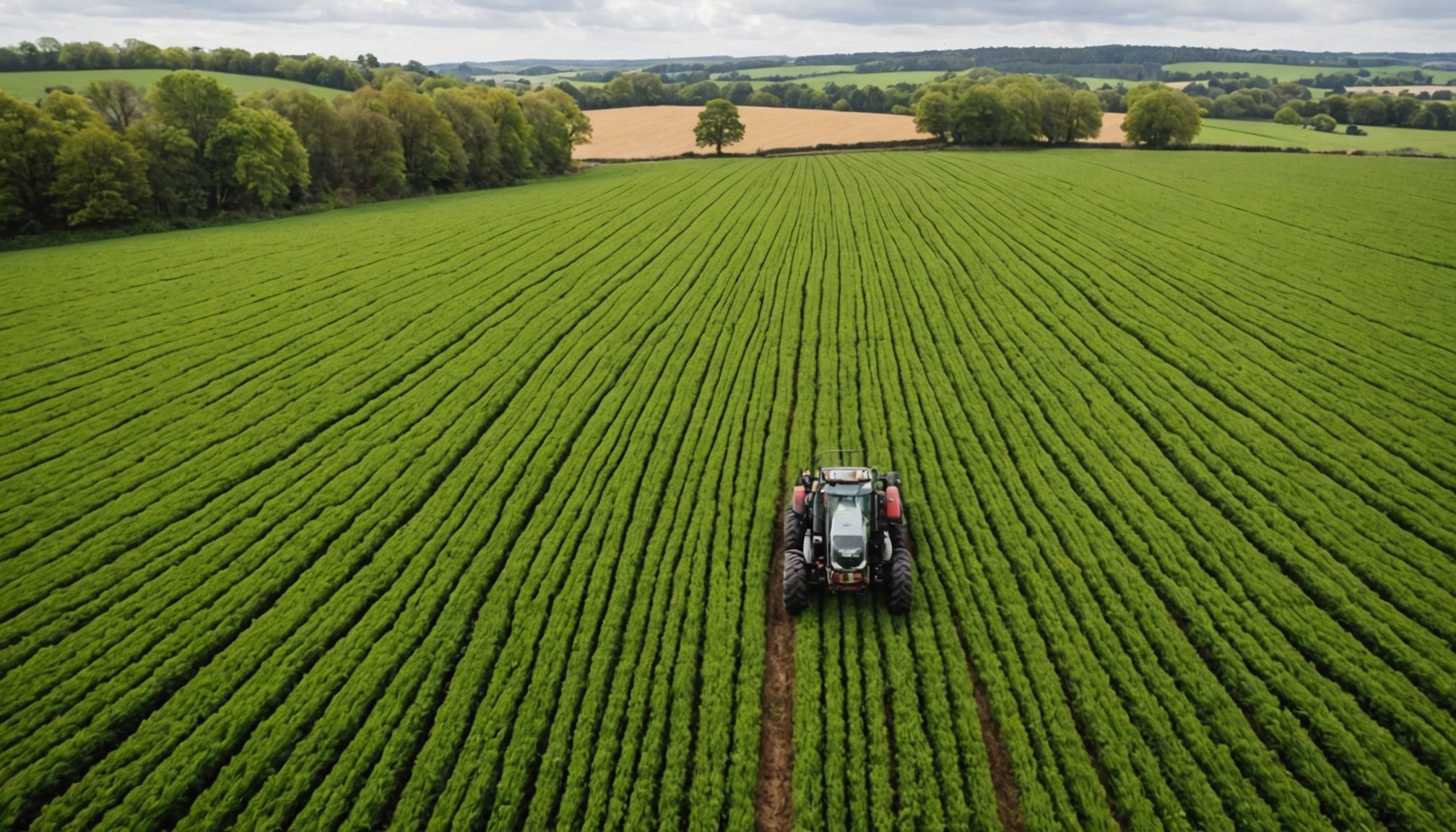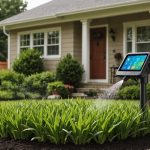Revolutionizing UK Agriculture: How AI is Transforming Precision Farming for a Sustainable Future
The Dawn of Precision Farming
Precision farming, or precision agriculture, is not a new concept, but it has undergone a significant transformation with the integration of artificial intelligence (AI) and machine learning. This shift is revolutionizing the agricultural sector, making farming more efficient, sustainable, and data-driven.
In the UK, as in many other parts of the world, farmers are embracing these new technologies to enhance their farming practices. The term “precision farming” encapsulates a range of techniques that use advanced technology to optimize crop yields, reduce waste, and improve soil health. Here’s how AI is at the forefront of this revolution.
Topic to read : Revolutionizing market dynamics: how ai is transforming opportunities for uk startups
Leveraging AI and Machine Learning
AI and machine learning are the star technologies driving precision farming forward. These technologies enable farmers to make informed decisions based on real-time data and predictive analytics.
Data-Driven Decision Making
AI systems can analyze vast amounts of data from various sources, including:
Have you seen this : Revolutionizing public services in the uk: harnessing ai to supercharge efficiency in administration
- Satellite Imagery: Providing detailed images of fields to monitor crop health and growth.
- Soil Sensors: Tracking soil moisture, pH levels, and nutrient content.
- Weather Stations: Predicting weather patterns to optimize planting and harvesting times.
- Drones: Equipped with cameras and sensors to detect early signs of disease and pests.
For instance, Étienne Lord, a researcher, highlighted the use of AI in creating profitability maps for fields. By combining agronomic and economic data, farmers can predict crop yields and identify areas that may not be profitable, allowing for more strategic management decisions[1].
Predictive Analytics
Machine learning algorithms can predict crop yields, detect anomalies, and forecast potential issues such as disease outbreaks or pest infestations. This predictive capability allows farmers to take proactive measures, reducing the environmental impact of farming practices.
### Example of Predictive Analytics in Action
- **Crop Yield Prediction**: Using historical data and current conditions, AI can predict the expected yield of a crop, helping farmers plan harvesting and storage.
- **Disease Detection**: AI-powered systems can analyze images from drones or satellite data to detect early signs of disease, enabling timely intervention.
- **Pest Management**: Machine learning can identify patterns in pest behavior, allowing for targeted and reduced use of pesticides.
Enhancing Crop Health and Soil Health
AI is not just about data analysis; it also plays a crucial role in maintaining the health of crops and soil.
Real-Time Crop Monitoring
With the use of drones and satellite imagery, farmers can monitor their crops in real time. This allows for immediate action to be taken if any issues are detected.
### Benefits of Real-Time Crop Monitoring
- **Early Disease Detection**: AI can identify signs of disease before they become severe, reducing the need for extensive chemical treatments.
- **Optimized Irrigation**: By monitoring soil moisture levels, AI can advise on the optimal times for irrigation, reducing water waste.
- **Precision Fertilization**: AI can recommend the exact amount and type of fertilizer needed based on soil conditions, minimizing over-fertilization.
Improving Soil Health
Soil health is a critical aspect of sustainable farming. AI can help in several ways:
### AI in Soil Health Management
- **Soil Mapping**: AI can create detailed maps of soil types and conditions, helping farmers choose the right crops and farming practices.
- **Nutrient Management**: By analyzing soil data, AI can recommend the optimal nutrient application, reducing soil degradation.
- **Erosion Prevention**: AI can identify areas prone to soil erosion and suggest measures to prevent it.
The Role of Robotics in Precision Farming
Robots are becoming increasingly integral to precision farming, particularly in tasks that require precision and efficiency.
Autonomous Farming Equipment
Robots equipped with AI can perform tasks such as:
- Precision Weeding: Robots can identify and remove weeds without damaging crops, reducing the need for herbicides[5].
- Automated Harvesting: Autonomous vehicles can harvest crops at the optimal time, ensuring maximum yield and quality.
- Livestock Monitoring: AI-powered robots can monitor the health and behavior of livestock, detecting early signs of illness or stress[4].
Environmental Impact and Sustainability
One of the most significant benefits of AI in precision farming is its potential to reduce the environmental impact of agricultural practices.
Reduced Chemical Use
AI-driven systems can optimize the use of pesticides, fertilizers, and other chemicals, minimizing their impact on the environment.
### Environmental Benefits of AI in Precision Farming
- **Reduced Pesticide Use**: Targeted pesticide application based on AI analysis can reduce chemical use by up to 70-80%[5].
- **Water Conservation**: AI can optimize irrigation systems, reducing water waste and ensuring that crops receive exactly what they need.
- **Soil Conservation**: By monitoring and managing soil health, AI can help prevent soil erosion and degradation.
Sustainable Farming Practices
AI promotes sustainable farming practices by encouraging the use of renewable resources and reducing waste.
### Sustainable Farming Practices Enabled by AI
- **Renewable Energy**: AI can optimize the use of renewable energy sources such as solar and wind power on farms.
- **Waste Reduction**: AI can help in reducing food waste by predicting crop yields and optimizing harvesting times.
- **Biodiversity**: By analyzing data on soil health and crop diversity, AI can suggest practices that promote biodiversity.
Challenges and Future Outlook
While AI is transforming the agricultural sector, there are several challenges that need to be addressed.
Investment and Accessibility
One of the main challenges is the high cost of these technologies, making them inaccessible to many small-scale farmers.
### Addressing the Challenges
- **Government Support**: Governments can provide subsidies and support for research and development in AI for agriculture, as seen in the US where the USDA has allocated significant funds for this purpose[3].
- **Education and Training**: Educational programs and training sessions can help farmers understand and adopt these new technologies.
- **Collaboration**: Collaboration between large and small farms, as well as between farmers and technology providers, can help in sharing resources and expertise.
Data Management and Security
Managing and securing the vast amounts of data generated by these systems is another significant challenge.
### Data Management and Security
- **Data Storage**: Secure and efficient data storage solutions are necessary to handle the large volumes of data.
- **Data Analytics**: Advanced data analytics tools are required to extract meaningful insights from the data.
- **Cybersecurity**: Ensuring the security of farm data is crucial to prevent unauthorized access and data breaches.
The integration of AI and machine learning in precision farming is revolutionizing the agricultural sector in the UK and globally. These technologies offer numerous benefits, from improved crop yields and soil health to reduced environmental impact and more sustainable farming practices.
As Étienne Lord noted, “By combining all the data, we are capable of having a model that will predict the yield of our field”[1]. This predictive capability, along with real-time monitoring and autonomous farming equipment, is setting the stage for a more efficient, sustainable, and data-driven future in agriculture.
Practical Insights and Actionable Advice
For farmers looking to adopt these technologies, here are some practical insights and actionable advice:
Start Small
Begin with basic technologies such as soil sensors and weather stations before moving to more advanced systems.
Seek Education and Training
Participate in educational programs and training sessions to understand how to use these technologies effectively.
Collaborate with Other Farmers
Share resources and expertise with other farmers to make these technologies more accessible.
Focus on Sustainability
Use AI to promote sustainable farming practices, such as reducing chemical use and conserving water.
By embracing these technologies and addressing the challenges associated with them, farmers can ensure a more sustainable and productive future for the agricultural sector.
Table: Comparison of Traditional and AI-Driven Farming Practices
| Farming Practice | Traditional | AI-Driven |
|---|---|---|
| Crop Monitoring | Manual inspection | Real-time monitoring via drones and satellites |
| Irrigation | Scheduled watering | Optimized irrigation based on soil moisture levels |
| Pest Management | Broad-spectrum pesticides | Targeted pesticide application based on AI analysis |
| Fertilization | Standard application rates | Precision fertilization based on soil conditions |
| Harvesting | Manual or mechanical harvesting | Autonomous harvesting vehicles |
| Soil Health | Periodic soil testing | Continuous monitoring with soil sensors |
| Yield Prediction | Historical data and experience | Predictive analytics using machine learning |
This table highlights the significant differences between traditional farming practices and those enhanced by AI, demonstrating the potential for improved efficiency, sustainability, and productivity in the agricultural sector.











